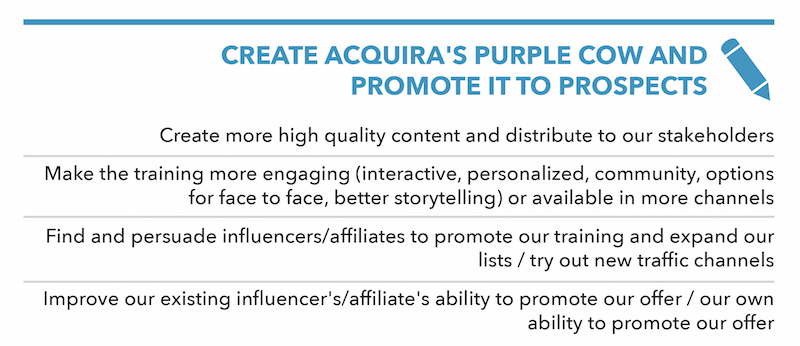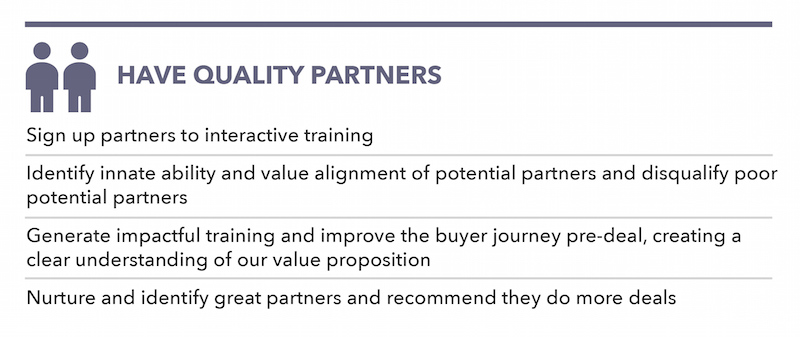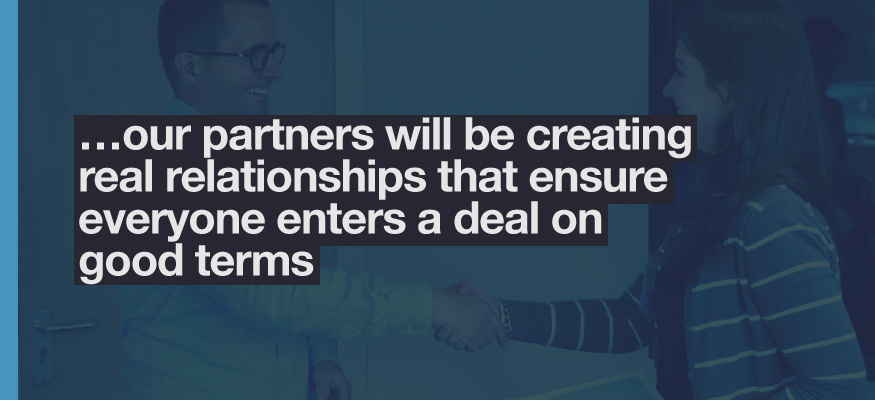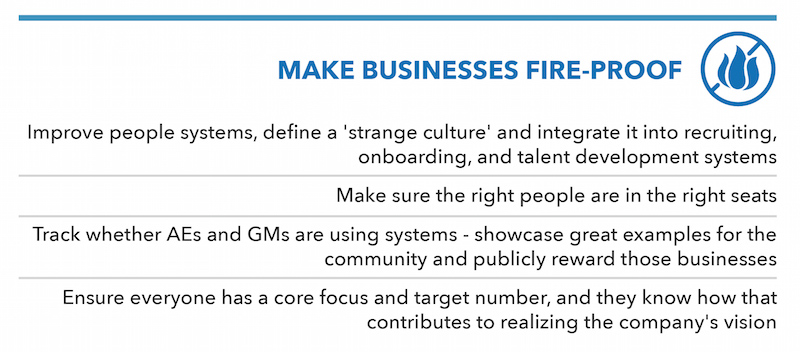- How the Flywheel method works.
- What the “Purple Cow” concept is.
- How Acquira constructed its Flywheel.
- How Acquira uses its Flywheel to find the best partners and the best deals.
- How the Flywheel can help a company give back to its community.
When your goal is to build a world-class investment fund and accelerator, it’s vital to have some sort of guiding strategy – a holistic system that drives your culture and informs your purpose.
At Acquira, we’ve adopted the Flywheel method as our guiding strategy.
The Flywheel concept was first introduced by Jim Collins in his book “Good to Great.” It’s a metaphor that symbolizes compounded investment of effort. We’ve talked about building your personal flywheel elsewhere but this can be applied to businesses as well as your personal life.
In the world of mechanical engineering, a flywheel is a device–a wheel–that stores kinetic energy. Collins asked his readers to imagine themselves pushing the heavy wheel on its axle. As you push the flywheel forward, it begins to move slowly, almost imperceptibly in the beginning. You continue pushing and the flywheel spins more, gaining speed as it completes a first and then second rotation. You continue this way, pushing and pushing, causing the flywheel to rotate faster and faster.

At some point, the momentum of the flywheel takes over and the device spins under its own power. Now, Collins points out that it is impossible to determine which push caused the flywheel to gain momentum. Indeed, it was the combined effort of each push, compounded with the previous pushes and combining with those that came after, that caused the flywheel to reach terminal velocity.
The Flywheel model has implications for inbound marketing, customer service, and any manner of other business applications.
We devised our Flywheel as a way to define our guiding principles. Each section of the flywheel feeds the one after it, which in turn feeds the next, and so on, until the Flywheel completes a rotation and the process starts over again. If you remove one section of the Flywheel, the momentum is lost and the whole process falls apart.
We believe it’s important to share our Flywheel with Acquira’s stakeholders: our employees, partners, and investors. It’s important to pull the curtain back and let everyone see how and why we do things. Transparency is crucial and we’re proud of what we’ve created. Hopefully, it can serve as inspiration to others as well.
So, without any further ado, let’s investigate Acquira’s Flywheel.
The Center
At the center of our Flywheel is the core concept that the entire structure revolves around.

“Creating training, systems, and a community culture to identify servant leaders and guide them through finding, buying, and growing a portfolio of businesses.”
We scale through training, creating systematic frameworks for our Acquisition Entrepreneurs to follow, which fosters a community of business owners that are servant leaders – people that believe in serving those that work for them.
Each segment of the Flywheel is designed to continue spinning, ensuring that we move this core concept forward. This is the guiding principle of Aquira.
How we push it forward is dependent on each section of the Flywheel, which has been carefully considered and systematized for success.
Step 1: Create Acquira’s Purple Cow and Promote It To Prospects

In his book “Purple Cow: Transform Your Business by Being Remarkable,” Seth Godin describes how advertising is less effective today due to oversaturation and increased advertising avoidance by consumers. He posits that companies should produce remarkable, interesting products to gain attention and help spread word of mouth.
We believe that Acquira is remarkable because we leverage our unique strengths to create and distribute great content to our stakeholders.
What Makes Acquira Remarkable?
“To me, what's made it remarkable has always been a two-part thing. The first part being the fact that Acquira is comprised of an internal team as well as a buyer community who have shared values and who are ultimately committed to helping each other level-up and become better versions of themselves. I never feel like I'm the smartest person in the room. I'm always learning from somebody and every day working in this company and working with our buyers just makes me a better person in many different ways.
The second part is that everything we do is centered around the ultimate goal of acquiring great businesses and then operating and growing them with excellence. This is a very high impact goal because small businesses have a tremendous influence on people's lives. Employees, customers, local communities. One business can touch literally thousands of people's lives.
So when you combine a community of people helping each other become better versions of themselves with buying businesses, you now extend that culture to the employees, customers, and communities, and all of a sudden you're helping people realize their full potential at scale, all over the world.
That's what makes Acquira a mission with a company instead of just another company with a mission.”
Kylon Gienger
President of Acquira
This also means making our training more engaging, finding influencers to promote our training and expand our lists, and trying new traffic channels. We also want to improve our existing influencers’ ability to promote our offerings.
If you’re creating great content and distributing it well, that naturally leads to great partners.
Step 2: Have Quality Partners

Having quality partners isn’t just about welcoming anyone who shows up. If the content is truly great, you’re going to get all kinds of people showing interest in your company. This next step means identifying great partners.
In this stage, we’ll have signed people up for interactive training, which we use to identify innate abilities and make sure their values are aligned with our own. We also need to disqualify poor potential partners here.
At its core, the nature of Acquira is training. So, if we can ensure we get good partners, they’re going to find the best deals that match our criteria.
The system we’ve created to ensure that we have quality partners is our Acceleration Gauntlet. It’s a training system that allows us to vet potential partners and it’s called the Gauntlet for a reason. It’s an in-depth course that demands a lot of attention and it allows potential partners to decide if they want to work for us.
But Acquira isn’t looking to work with just anybody. Our Gauntlet is a methodic, systematic process that allows us to determine who we want to work with.
Hear Acquira Co-Founder Hayden Miyamoto explain why finding good partners is so important:
Step 3: Find Deals That Match Our Criteria

At this stage of the flywheel, we need to concentrate on validating new ways to find businesses and training our partners in those methods.
Cold calling, mass emailing, direct mail, setting up relationships with brokers, creating a seller funnel using Facebook traffic: these are just some of the ways we can find more businesses for sale.
This stage also involves improving the pre-LOI (Letter of Intent) seller journey.
We do this by identifying milestones within the first 100 days of the interaction with the seller and looking for ways to surprise and delight them. That way, our partners can create a greater rapport and a better relationship with the sellers.

While other potential buyers may just be putting in an offer, our partners will be creating real relationships that ensure everyone enters a deal on good terms.
Validating new financing options is also very important because it allows us to expand our addressable market. We use the SBA (Small Business Administration) for a lot of our financing, but that only applies to the United States. New financing options could help our partners buy in Canada, Australia, or the United Kingdom, for example. These could allow for more flexible deal terms and help us close deals much faster.
By giving our partners effective training, such as in Acquira’s Acceleration Program, they’ll be able to go out and find great deals on their own.
While the items above allow us to find more businesses, improving pre-LOI diligence and disqualification criteria permit us to determine which businesses would not make suitable acquisitions. While finding potential acquisitions is at the core of our business, disqualifying bad acquisitions is just as important. The faster we can do this, the fewer resources we waste combing through the financials of a company we will never buy.
Finally, we handle communication and design in order to improve the buyer journey because we want to make this experience as smooth as possible. If our acquisition entrepreneurs aren’t happy, they won’t ever get to the point where they can issue a letter of intent (LOI).
Step 4: Close Evergreen, All-Season Businesses With Asymmetrical Terms
(limited downside, unlimited upside)

If we publish good content, we find good people. We then turn those people into partners, teach those partners to find deals, and make sure that the deals they close are great.
Evergreen businesses are not trend-based. They aren’t trampoline parks or escape rooms. They’re businesses that serve basic societal functions like roofing and plumbing. Because everybody needs a roof and everybody poops.
They’re businesses that we’ll always need (and ideally, they’re ones that are less vulnerable to disruption from Artificial Intelligence).
By improving our post-LOI diligence training, we make it easier for the buyer to disqualify bad deals. This ultimately improves the seller journey post-LOI, simply because all parties are sure they want the deal to go through.
We’re also improving financing close rates so that we don’t lose great deals because they can’t be financed. To help reach this goal, we are actively working on creating our own debt fund that would replace SBA. That would mean people wouldn’t need to do a personal guarantee, it means we could work with non-US citizens, and we could buy businesses outside of the United States. It would also allow us to close deals more quickly because we would be able to fund them ourselves.
These all-season businesses are generally recession-resilient. These types of businesses offer limited downside and unlimited upside, but we don’t want to become complacent and only work with one type of company or within one segment of the market. So, when we expand our serviceable market by targeting new types of businesses, we can ensure we don’t become overly reliant on a single type of business.
Step 5: Make Businesses Fire-Proof

The natural consequence of closing good deals is that you then own good businesses.
You then set about bettering that already good business by improving people systems, designing a “strange culture,” and integrating that into your recruiting, onboarding, and talent development systems. That process then ensures that the right people are sitting in the right seats.
In order to truly fire-proof a business, it’s integral to make sure that all of your GMs and AEs are using the proper systems to make the business run smoothly. You can do this by showcasing great examples of effective systems for the community and publicly rewarding the businesses using them.
These common systems and processes will help ensure that everyone has a core focus and a target number to strive for, as well as how those objectives contribute to the company’s vision.
Once these things are in place, the business is fire-proof.
Step 6: Give and Grow Businesses

By fire-proofing the company, you’ll be able to ensure that you actually have the time to dedicate to growing the company. It also means the company is efficient enough that you will have the excess cash to invest into growth – because growth costs money.
It’s important to understand that this is a long-term investment. But it’s impossible to make a long-term investment when people have no time and you have no money. That’s why small businesses stay small – they don’t ensure that they’re fire-proofed before growing their business.
Once you have the cash to invest, you can start improving your digital marketing, reinforcing a compelling vision and value system, and improving procedures and training for your expanding product or service offerings.
By investing time and money into each of these facets of the business we can ensure that Acquira continues to grow.
At this point, we can also start to give back to the employees and communities that have supported our growth. While giving back to the stakeholders that helped us reach this point is clearly the right thing to do, it also provides a high ROI (return on investment) and will reap future rewards in the form of word-of-mouth referrals, good reviews, and staff retention. It also makes it easier to recruit employees.
If you’re able to grow your business and give back, you’ll begin to see success stories from your employees and the community. Their lives will improve, the community will improve, and that creates perfect content to continue creating and promoting to your prospects. It also brings us back to the beginning of our flywheel.
We use those success stories to create new content, which brings in new partners, and the Flywheel continues to spin.
The Invention of the Acquira Flywheel
As we discussed in the Personal Flywheel article, there are several steps we go through to create a Flywheel. In his monograph, Jim Collins lists the steps as:
- Create a list of significant replicable successes your enterprise has achieved. This should include new initiatives and offerings that have far exceeded expectations.
- Compile a list of failures and disappointments. This should include new initiatives and offerings by your enterprise that have failed outright or fell far below expectations.
- Compare the successes to the disappointments and ask, “What do these successes and disappointments tell us about the possible components of our flywheel?”
- Using the components you’ve identified (keeping it to four to six), sketch the flywheel. Where does the flywheel start—what’s the top of the loop? What follows next? And next after that? You should be able to explain why each component follows from the prior component. Outline the path back to the top of the loop. You should be able to explain how this loop cycles back upon itself to accelerate momentum.
- If you have more than six components, you’re making it too complicated; consolidate and simplify to capture the essence of the flywheel.
- Test the flywheel against your list of successes and disappointments. Does your empirical experience validate it? Tweak the diagram until you can explain your biggest replicable successes as outcomes arising directly from the flywheel, and your biggest disappointments as failures to execute or adhere to the flywheel.
- Test the flywheel against the three circles of your Hedgehog Concept. A Hedgehog Concept is a simple, crystalline concept that flows from deeply understanding the intersection of the following three circles: (1) what you’re deeply passionate about, (2) what you can be the best in the world at, and (3) what drives your economic or resource engine. Does the flywheel fit with what you’re deeply passionate about—especially the guiding core purpose and enduring core values of the enterprise? Does the flywheel build upon what you can be the best in the world at? Does the flywheel help fuel your economic or resource engine?
We began constructing the Acquira Flywheel in the standard way, by looking at our historic strengths and historic weaknesses.
In our past endeavors, we had always been great at creating a purple cow and promoting that to prospects. We were also very strong and created systems around processes. So that’s where we started.
When we looked at past failures we realized that, often, we suffered from “shiny object syndrome” and a lack of sticking power. That realization encouraged us to concentrate on a training system, using the purple cow to find partners and create a network of people that will do the work themselves.
We’re creating an asset through training and guidance that is infinitely exchangeable.
How Is Acquira’s Flywheel Different?
The difference between what Jim Collins talks about and what we did, is that Acquira broke down the sections of its Flywheel into unique items and assigned those to someone on the leadership team. Those leaders are in charge of making sure those sections of the Flywheel continue moving.
Moreover, Acquira tied these segments of the Flywheel to key results. These results are a specific type of concrete, attainable, time-bound goal. These goals are measurable, attainable, and realistic. They are strategic initiatives that have been identified as priorities for the company.
So each leader has an objective they need to hit each quarter, which goes toward an annual goal, which in turn goes toward a long-term goal. All of that is tied to the Flywheel.
The Flywheel informs our strategy and goal setting. What is our quarterly goal? What is our annual goal? And how can we monetize it directly? Especially as an investment business, determining how to monetize each step of the Flywheel ensures that we have an economic engine that allows it to turn.
Conclusion
Building a world-class investment fund and accelerator isn’t an easy task. But it’s the one we’ve given ourselves and one we’ve happily undertaken.
With our Flywheel, we have found a system of propulsion to move our company forward and help each of our stakeholders, from employee to investor to buyer and seller. This Flywheel is intended to improve the lives of each of them and the communities that surround us.
It’s our guiding strategy.
Acquira specializes in seamless business succession and acquisition. We guide entrepreneurs in acquiring businesses and investing in their growth and success. Our focus is on creating a lasting, positive impact for owners, employees, and the community through each transition.



